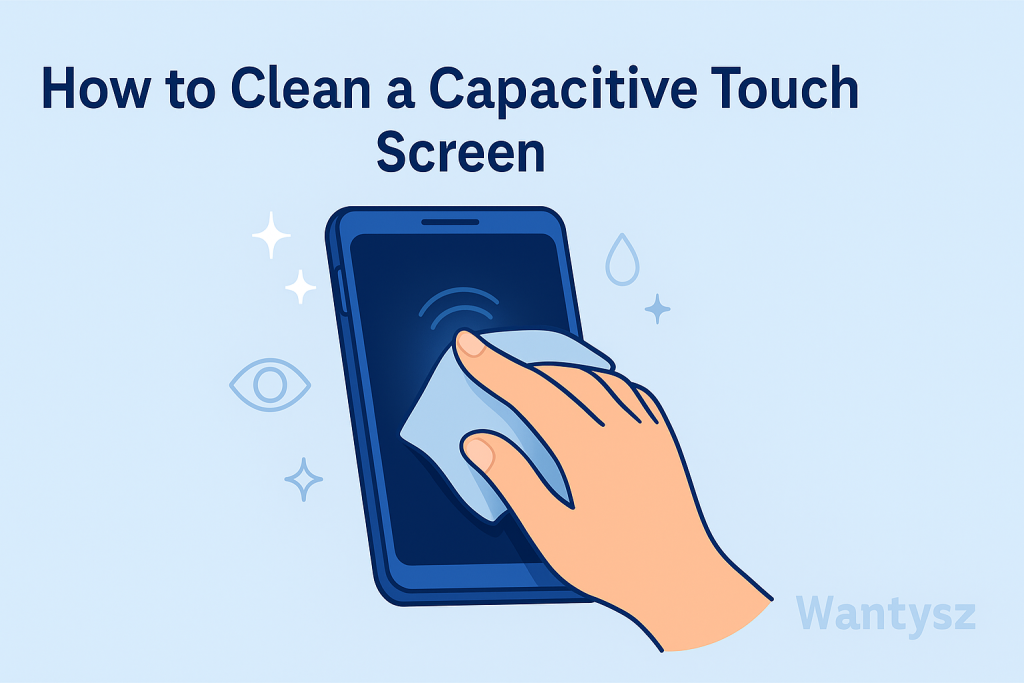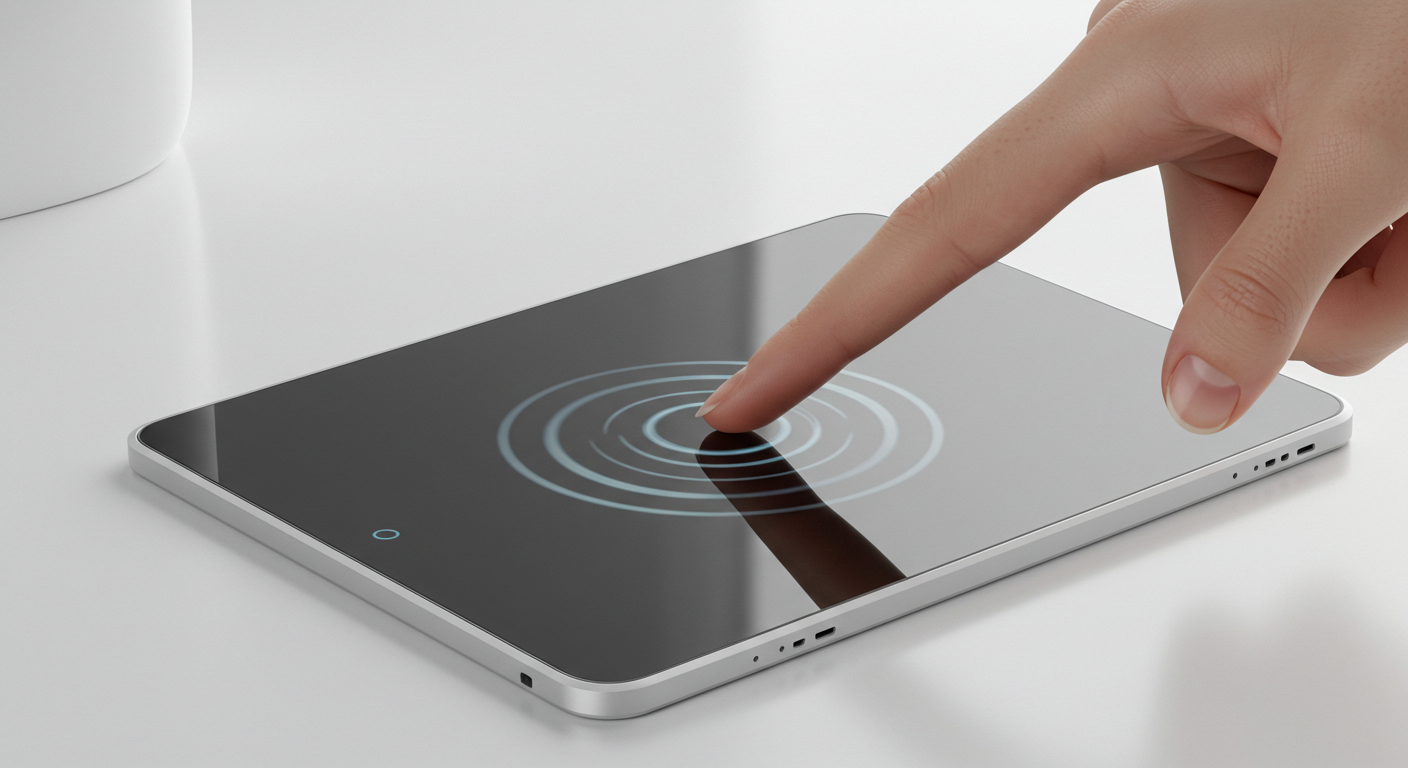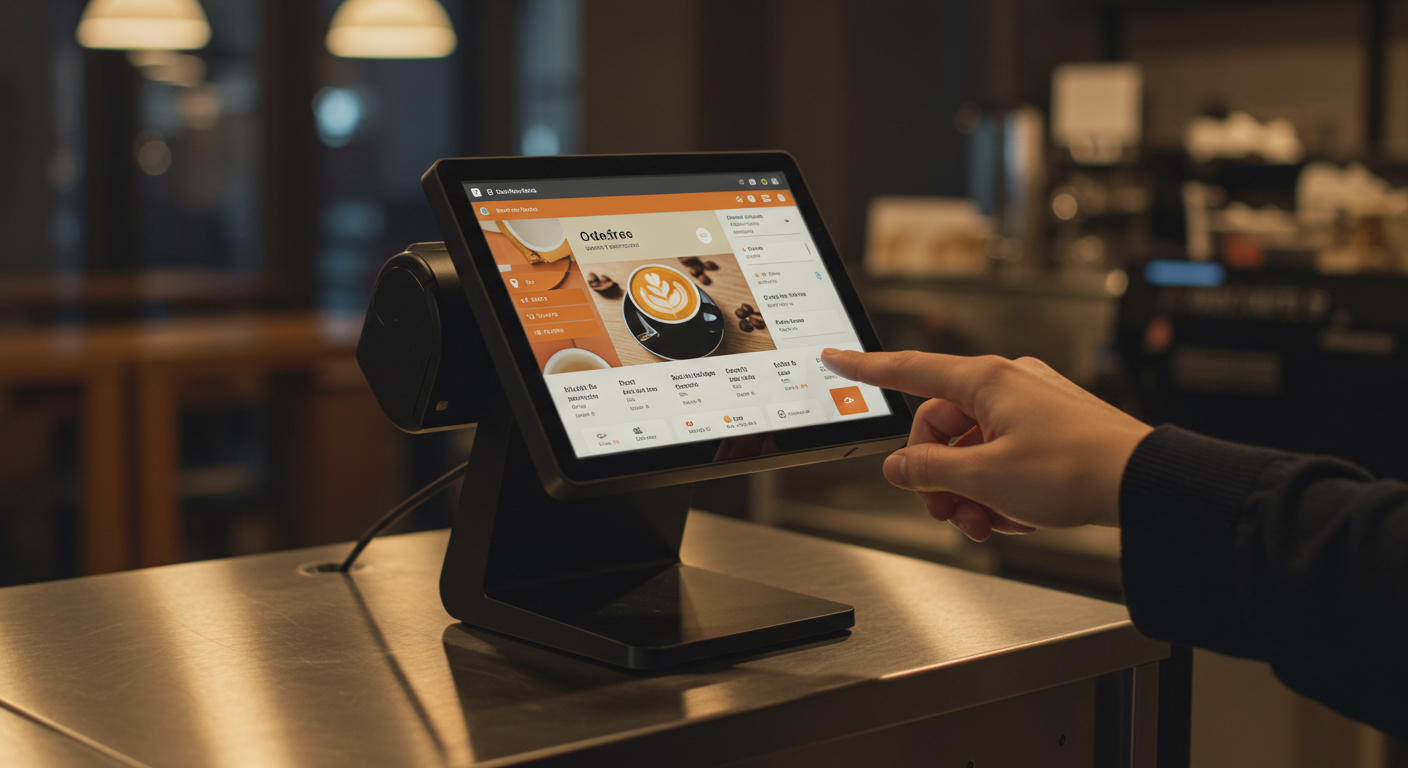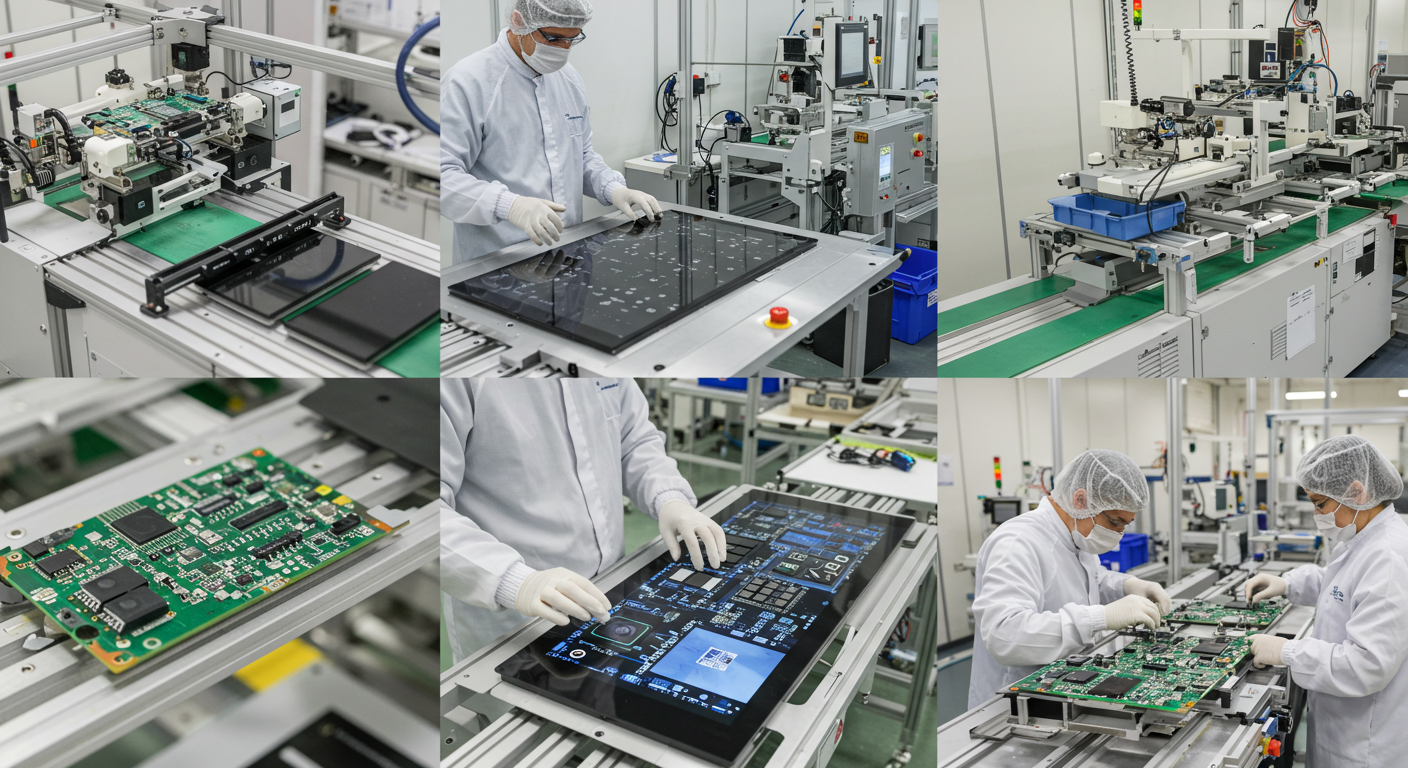How to Clean a Capacitive Touch Screen: Easy Tips for a Streak-Free Display
News
Jun-22-2025
Tired of smudges and fingerprints clouding your phone or tablet screen?
A clean capacitive touch screen makes your device look sharp and respond better. Dirty screens can mess with touchscreen sensitivity and ruin your user experience.
Want to keep your screen sparkling without scratching it? This guide shares simple, safe touchscreen cleaning tips to remove smudges and keep your device in top shape.
Let’s dive into how to clean a capacitive touch screen the right way in 2025, with step-by-step instructions and practical advice!

Why Cleaning Your Capacitive Touch Screen Properly Matters
Your smartphone, tablet, or kiosk screen gets touched all day, collecting fingerprints, dust, and germs. Keeping it clean isn’t just about looks—it ensures touch accuracy and a smooth user experience. A dirty capacitive touch screen can slow down responsiveness or misread taps, making your device frustrating to use. Plus, a clean screen looks vibrant and professional, whether it’s your phone or a public display. This guide will show you how to clean a capacitive touch screen safely and keep it streak-free.
Impact on Performance
A clean screen maintains touchscreen sensitivity, ensuring every tap and swipe works perfectly.
Hygiene and Appearance
Regular screen smudge removal keeps your device germ-free and looking brand-new.
What Makes Capacitive Touch Screens Different?
Capacitive touch screens detect your touch using an electrical field created by a conductive layer, usually indium tin oxide (ITO). Unlike resistive screens, which need pressure, capacitive screens are super sensitive to light touches. Their glass surface is durable but can still scratch if cleaned improperly.
Why Cleaning Matters for Capacitive Screens
The glass surface attracts smudges and oils, which can disrupt the electrical field and affect touch accuracy.
Sensitivity to Cleaning Methods
Capacitive screens need gentle care to avoid damaging the conductive layer or protective coatings.
Common Dirt and Smudges Found on Touch Screens
Capacitive screens pick up all sorts of grime from daily use. Here’s what you’re likely dealing with:
- Fingerprints: Oils from your fingers leave smudges that cloud the screen.
- Dust and Dirt: Tiny particles settle on the glass surface, especially on outdoor devices.
- Food Residue: Crumbs or grease from snacks can stick to your screen.
- Germs and Bacteria: Public touchscreens, like kiosks, can harbor germs.
- Makeup or Lotions: Cosmetics can smear on phone screens during calls.
Regular screen smudge removal keeps these from building up and affecting performance.
How Dirt Accumulates
Constant touching, especially on phones or public displays, makes dirt buildup inevitable.
Impact on Visibility
Smudges and dust can dim the high clarity display, making it harder to read in bright light.
Why Using the Wrong Cleaning Method Can Damage Your Screen
Cleaning a capacitive touch screen the wrong way can cause serious issues. Harsh chemicals, rough cloths, or too much pressure can:
- Scratch the glass surface, reducing clarity and touch sensitivity.
- Damage the conductive layer, causing unresponsive spots.
- Strip protective coatings, making the screen prone to smudges or cracks.
- Leave streaks, affecting the user experience and visual quality.
Using the right touchscreen cleaning tips prevents these problems and keeps your screen in top shape.
Risks of Harsh Chemicals
Chemicals like bleach or ammonia can erode coatings, harming touchscreen sensitivity.
Dangers of Abrasive Materials
Rough towels or paper can scratch the glass surface, leading to permanent damage.
Essential Cleaning Tools You’ll Need
To clean a capacitive touch screen safely, gather these tools:
- Microfiber Cloth: Soft, lint-free, and perfect for streak-free cleaning.
- Screen-Safe Cleaner: A solution designed for electronics, not household cleaners.
- Distilled Water: Safe for diluting cleaners or light cleaning.
- Compressed Air: Removes dust from edges or crevices.
- Cotton Swabs: Handy for cleaning corners or tight spots.
These tools ensure safe, effective screen smudge removal without damage.
Where to Find Tools
Microfiber cloths and screen-safe cleaners are available at electronics stores or online.
Budget-Friendly Options
A basic microfiber cloth and distilled water work well for most cleaning tasks.
Step-by-Step Cleaning Guide: Preparing the Screen
Before you start, prep your capacitive touch screen to avoid mistakes:
- Turn Off the Device: Power down to prevent accidental taps and ensure safety.
- Remove Any Case: Take off cases or covers to access the entire screen.
- Check for Debris: Gently brush off loose dust or particles with a dry microfiber cloth.
- Work in a Clean Area: Avoid dusty or dirty spaces to keep new grime off the screen.
Prepping properly sets you up for a streak-free cleaning experience.
Why Powering Off Helps
A powered-off screen is safer to clean and lets you see smudges more clearly.
Avoiding Dust Contamination
Cleaning in a dust-free area prevents new particles from sticking to the wet screen.
Step-by-Step Cleaning Guide: Using a Microfiber Cloth
A microfiber cloth is your best friend for cleaning touch devices. Here’s how to use it:
- Dry Wipe First: Gently wipe the screen with a dry microfiber cloth to remove loose dust.
- Fold the Cloth: Fold it into a small square for better control and a clean surface.
- Wipe in Circles: Use light, circular motions to lift smudges without pressing hard.
- Check All Areas: Pay attention to edges and corners where dirt collects.
This method ensures streak-free cleaning without scratching the glass surface.
Choosing the Right Cloth
Use a clean, lint-free microfiber cloth designed for electronics, not a regular towel.
Technique Tips
Light pressure and small circles work best to avoid streaks or damage.
Step-by-Step Cleaning Guide: Using Screen-Safe Cleaners
For tougher smudges, a screen-safe cleaner can help. Follow these steps:
- Spray Sparingly: Mist a small amount of screen-safe cleaner onto the microfiber cloth, not the screen.
- Wipe Gently: Use light, circular motions to clean the entire glass surface.
- Dry the Screen: Use a dry part of the cloth to remove any leftover moisture.
- Inspect for Streaks: Hold the screen under light to check for missed spots.
Never spray liquid directly on the screen—it can seep into edges and cause damage.
Picking a Safe Cleaner
Choose cleaners labeled for electronics, like those for phones or laptops, to protect the conductive layer.
Avoiding Over-Wetting
Too much liquid can harm the screen’s coatings or seep into the device, so use minimal amounts.
How to Remove Stubborn Smudges and Fingerprints
Stubborn smudges, like grease or makeup, need extra care. Try this:
- Dampen the Cloth: Lightly dampen a microfiber cloth with distilled water or screen-safe cleaner.
- Target the Smudge: Gently rub the spot in small circles, using light pressure.
- Use a Cotton Swab: For tiny areas, a damp cotton swab can help with precision.
- Dry Thoroughly: Wipe with a dry microfiber cloth for streak-free cleaning.
Patience is key—don’t scrub hard, as it can scratch the glass surface.
Dealing with Grease
Greasy smudges from food or lotions may need a second pass with a screen-safe cleaner.
When to Repeat
If smudges persist, repeat the process rather than pressing harder to avoid damage.
Disinfecting Your Touch Screen Safely
Public touchscreens, like kiosks, or personal devices can harbor germs. Here’s how to disinfect safely:
- Use a Disinfecting Wipe: Choose wipes made for electronics, not household disinfectants.
- Wipe Gently: Lightly wipe the glass surface to avoid damaging coatings.
- Dry Immediately: Use a microfiber cloth to remove moisture and prevent streaks.
- Limit Frequency: Disinfect only when needed to protect the conductive layer.
Disinfecting keeps your screen hygienic without harming its touchscreen sensitivity.
Safe Disinfecting Products
Look for alcohol-free wipes or sprays designed for screens to avoid corrosion.
Frequency for Public Devices
High-traffic screens, like those in restaurants, may need daily disinfecting for hygiene.
Avoid These Common Cleaning Mistakes
Steer clear of these pitfalls when cleaning touch devices:
- Harsh Chemicals: Avoid bleach, ammonia, or alcohol-based cleaners that can strip coatings.
- Rough Materials: Don’t use paper towels, tissues, or rough cloths—they can scratch.
- Spraying the Screen: Liquid can seep into edges, damaging the conductive layer.
- Excessive Pressure: Pressing too hard can crack the glass surface or harm sensors.
- Cleaning While Powered On: Accidental taps can cause issues, so always power off.
These mistakes can ruin your screen’s performance and appearance.
Why Chemicals Are Risky
Harsh cleaners can erode protective coatings, reducing touch accuracy and clarity.
Safe Alternatives
Stick to microfiber cloths and screen-safe cleaners for worry-free cleaning.
Tips for Maintaining a Clean Screen Daily
Prevent dirt buildup with these daily habits:
- Wash Your Hands: Clean hands reduce fingerprints and oils on the glass surface.
- Use a Case: A case or cover protects the screen when not in use.
- Avoid Food Near Devices: Keep snacks away to prevent crumbs or grease.
- Store Properly: Keep devices in clean, dust-free places when not in use.
These habits make screen smudge removal easier and less frequent.
Routine Wipe-Downs
A quick dry wipe with a microfiber cloth daily keeps smudges at bay.
Travel Tips
Carry a small microfiber cloth in your bag for on-the-go streak-free cleaning.
How Often Should You Clean Your Capacitive Touch Screen?
Cleaning frequency depends on use:
- Personal Devices: Clean phones or tablets weekly or when smudges appear.
- Public Devices: Clean kiosks or POS terminals daily, especially in high-traffic areas.
- Industrial Screens: Clean weekly or after heavy use in dusty or greasy settings.
Regular cleaning maintains touchscreen sensitivity and keeps the high clarity display sparkling.
Signs It’s Time to Clean
If taps feel sluggish or the screen looks hazy, it’s time for screen smudge removal.
Balancing Cleanliness and Care
Over-cleaning can wear coatings, so clean only when needed to preserve the glass surface.
Protective Measures: Screen Protectors and Covers
Screen protection extends your capacitive screen’s life. Consider these:
- Screen Protectors: Tempered glass or plastic films shield against scratches and cracks.
- Cases with Covers: Flip cases protect the screen when not in use.
- Anti-Glare Films: Reduce reflections and smudges for better visibility.
Choosing a Screen Protector
Pick a protector designed for capacitive screens to maintain touch accuracy.
Easy Application Tips
Clean the screen thoroughly before applying a protector for a bubble-free fit.
Cleaning Touch Screens in Different Environments
Cleaning needs vary by setting. Here’s how to handle different environments:
- Home or Office: Use a microfiber cloth and screen-safe cleaner for routine screen smudge removal.
- Outdoor Kiosks: Clean more often due to dust or rain; use water-resistant PCAP screens for durability.
- Industrial Settings: Remove grease or dust with a damp microfiber cloth and dry thoroughly.
- Medical Environments: Disinfect with electronics-safe wipes to maintain hygiene without damage.
Each setting has unique challenges, but proper tools ensure safe cleaning. Learn more about uses in Capacitive touch screen use cases.
Outdoor Cleaning Challenges
Dust and water require frequent cleaning and durable screen protection for outdoor screens.
Industrial Cleaning Needs
Greasy or dusty environments need tougher cleaners but still safe for the conductive layer.
DIY Cleaning Solutions: What Works and What to Avoid
DIY cleaning can work if done right. Here’s what to use and avoid:
- Safe DIY Solution: Mix distilled water with a tiny drop of dish soap (1:100 ratio) for gentle cleaning.
- Apply Sparingly: Dampen a microfiber cloth lightly, never the screen directly.
- Avoid Vinegar: It can damage coatings on the glass surface.
- Skip Alcohol: High concentrations harm the conductive layer.
- No Tap Water: Minerals can leave streaks or damage the screen.
Stick to screen-safe cleaners or minimal water for the best results.
Testing DIY Solutions
Test your mix on a small corner first to ensure it’s safe for streak-free cleaning.
When to Buy Commercial Cleaners
For heavy smudges, commercial screen-safe cleaners are more effective and safer.
Cleaning and Caring for Custom Capacitive Touch Screens
Custom capacitive screens, like those in car dashboards or industrial displays, need special care. Their glass surface or coatings may vary, so check the manufacturer’s guidelines. PCAP screens, used in rugged settings, often have thicker glass or glove-compatible features, requiring gentle cleaning to maintain touch accuracy.
Use a microfiber cloth and screen-safe cleaner to avoid damaging custom coatings. For tailored solutions, see Capacitive touch custom screen.
Caring for PCAP Screens
PCAP screens need extra care to preserve their glove or water-resistant features during cleaning.
Manufacturer Guidelines
Always follow specific instructions for custom screens to protect their unique conductive layer.
Impact of Cleanliness on Touch Accuracy and Responsiveness
A dirty capacitive touch screen can mess with touchscreen sensitivity. Smudges, oils, or dust can disrupt the electrical field, causing misread taps or sluggish responses. Regular screen smudge removal ensures touch accuracy and a smooth user experience.
For example, a smudged phone screen might miss your taps, making typing or gaming frustrating. Clean screens keep your device responsive and reliable. Want to know how the tech works? Check out How capacitive touch screens work.
How Dirt Affects Sensors
Oils and grime can block the conductive layer, reducing touch input detection accuracy.
Restoring Performance
Cleaning restores the high clarity display and touchscreen sensitivity for a like-new feel.
Frequently Asked Questions About Touch Screen Cleaning
Q: Can I use alcohol wipes to clean a capacitive touch screen?
A: Avoid alcohol wipes—they can damage the conductive layer. Use screen-safe cleaners instead.
Q: How do I disinfect my touchscreen safely?
A: Use electronics-safe disinfecting wipes and dry with a microfiber cloth for streak-free cleaning.
Q: Can a scratched screen affect touch accuracy?
A: Minor scratches usually don’t, but deep ones can disrupt the electrical field. Use a screen protector to prevent this.
Q: How often should I clean public touchscreens?
A: Daily for high-traffic devices like kiosks to ensure hygiene and touchscreen sensitivity.
Conclusion: Keep Your Screen Clean for Best Performance
A clean capacitive touch screen is key to a great user experience. With touchscreen cleaning tips like using a microfiber cloth, screen-safe cleaners, and proper techniques, you can keep your screen streak-free and responsive. Regular screen smudge removal maintains touch accuracy, enhances clarity, and keeps your device hygienic, whether it’s a phone, kiosk, or custom display. In 2025, keeping your capacitive touch screen clean is easier than ever with the right tools and habits.
Ready to keep your touchscreen sparkling or need a custom solution? Contact a trusted provider to explore High-resolution custom LCD options for your project.
Related Topics

Capacitive Touch Integrated Touchscreen: 2025 Technology
Aug-25-2025

Capacitive Touch Screen POS Terminal – Next-Gen Solutions
Aug-25-2025

Capacitive Touch HMI Interface | Durable & Ergonomic Control
Aug-24-2025

Capacitive Panel OEM Manufacturers – Custom Touchscreen Solutions
Aug-24-2025
Get a Free Quote
✔ 16 Years Manufacture Service ★★★★★
✔ 3 Technical Experts And 52+ Project Engineers Will Assiste You
✔ Wanty Employs Over 52 Engineers, Many Of Whom Come From Leading Tft Lcd Module Companies Such As Tianma And Boe-Varitronix. Each Core Team Member Brings 15 Years Of Industry Experience.
✔ If you would like more information about our products and services, please contact us. Whether you need a standard solution or a customized one, we are here to meet your needs.
✔ Please complete the form below, and the selected location will contact you promptly. Thank you for visiting, and have a great day!
